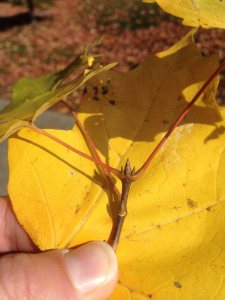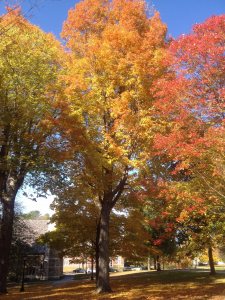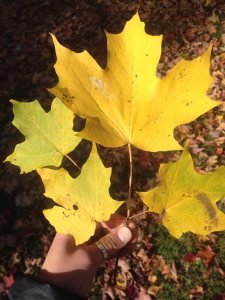Sugar Maple
Acer saccharum| Family: Sapindaceae
Submission: Isobel Curtis ’17
Leaves – simple, deciduous, usually 5-lobed, and with entire margins.
Twigs – opposite branching; lustrous.
Buds – imbricated, brown, and sharply pointed.
Fruit – ¾-1″ U-shaped samaras that mature in the fall.
Bark – variable, gray (often with a brown tinge), and furrowed-scaly when older.
Sugar maple (Acer saccharum) is a deciduous tree also referred to as hard maple or rock maple. It is one of the largest and most important hardwood species in North America, typically reaching 70-90 feet in height with a dense, spreading crown. Sugar maple is a shade tolerant tree common in many northern hardwood and mixed forests. It does best on moist, well-drained soils and poorly on dry, shallow, or swampy soils. The range of sugar maple extends from Nova Scotia and Quebec at its northern edge, west to Ontario, southeastern Manitoba, and western Minnesota, south to southern Missouri, and east to Tennessee and northern Georgia.
 Sugar maple has huge historical and economic importance for its use in the maple sugar and timber industries. It is the state tree of New York and is featured on the Canadian flag, evidence of its value to the Northern territories. It is the favorable tree for syrup production as the sap contains twice the sugar concentration of any other maple species (~2.5% sugar). Trees are tapped in early spring when the sap begins to flow and sugar content is highest. An individual tree can produce 5-60 liters of sap per day, which may sound like a lot, but 35-45 liters of sap are required to make 1 liter of syrup. The watery sap is boiled or evaporated into a thick syrup or undergoes further evaporation to produce maple sugar, a common candy. Along with honey, sugar maple was the main source of sweetener for Native Americans and early European settlers. Native Americans also used the sap as a fresh or fermented beverage or soured as vinegar when cooking meat. The wood is valued for being hard, heavy and strong; common uses include furniture, flooring, and veneer as well as tool handles, musical instruments, and baseball bats. Sugar maple constitutes about 6% of the hardwood saw timber value in the US, with rising production of saw timber and firewood.
Sugar maple has huge historical and economic importance for its use in the maple sugar and timber industries. It is the state tree of New York and is featured on the Canadian flag, evidence of its value to the Northern territories. It is the favorable tree for syrup production as the sap contains twice the sugar concentration of any other maple species (~2.5% sugar). Trees are tapped in early spring when the sap begins to flow and sugar content is highest. An individual tree can produce 5-60 liters of sap per day, which may sound like a lot, but 35-45 liters of sap are required to make 1 liter of syrup. The watery sap is boiled or evaporated into a thick syrup or undergoes further evaporation to produce maple sugar, a common candy. Along with honey, sugar maple was the main source of sweetener for Native Americans and early European settlers. Native Americans also used the sap as a fresh or fermented beverage or soured as vinegar when cooking meat. The wood is valued for being hard, heavy and strong; common uses include furniture, flooring, and veneer as well as tool handles, musical instruments, and baseball bats. Sugar maple constitutes about 6% of the hardwood saw timber value in the US, with rising production of saw timber and firewood.
Sugar maple is of high ecological importance, providing food and shelter for a wide variety of organisms. White-tailed deer, moose, porcupine, squirrels and snowshoe hare commonly eat the bark, twigs, or fruit of the sugar maple. Songbirds, woodpeckers, and cavity nesters use the sugar maple as a home.
References:
Brockman, C.F. 1986. Trees of North America: A Guide to Field Identification. Revised Edition. Western Pub. Co., Inc. 280pp.
Burns, R.M. and Honkala, B.H., 1990. Silvics of North America (Vol. 2). United States Department of Agriculture.
Elias, T.S. 1980. The Complete Trees of North America Field Guide and Natural History. Van Nostrand Reinhold Co., N.Y. 948pp.
Harlow, W.M., Harrar, E.S., Hardin, J.W. and White, F.M. 1991. Textbook of Dendrology. McGraw-Hill Inc., N.Y. 501pp.
Luzadis, V.A. and E.R. Gossett. 1996. Sugar Maple. Pages 157-166. Forest Trees of the Northeast, edited by Lassoie, Luzadis, and Grover. Cooperative Extension Bulletin 235. Cornell Media Services.
Nesom, Guy. 2006. Plant Guide: Sugar Maple, USDA NRCS National Plant Data Center & the Biota of North America Program.
Petrides, G.A. 1972, A Field Guide to Trees and Shrubs. 2nd edition. Houghton Mifflin Co., Boston. 428pp.
Preston, R.J., Jr. 1989. North American Trees. 4th edition. Iowa State Univ. Press. Ames. 407pp.
Shane, J. 2004. Dendrology Handbook, University of Vermont, Unpublished

